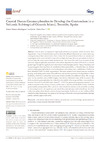Identificador persistente para citar o vincular este elemento:
https://accedacris.ulpgc.es/jspui/handle/10553/114390
| Título: | Coastal Dunes Geomorphosites to Develop the Geotourism in a Volcanic Subtropical Oceanic Island, Tenerife, Spain | Autores/as: | Marrero Rodríguez, Néstor Dóniz-Páez, Javier |
Clasificación UNESCO: | 531290 Economía sectorial: turismo 250607 Geomorfología |
Palabras clave: | Arid Aeolian Depositional Systems Cultural Heritage Geomorphosites Geotourism Itineraries, et al. |
Fecha de publicación: | 2022 | Publicación seriada: | Land | Resumen: | Coastal areas are exposed to high levels of human occupation, which has led to their degradation. Coastal dunes have been greatly altered by different historical and current land uses, causing the loss of their natural and cultural values. On the coast of Tenerife there are volcanic and organogenic sand active and relict dunes with multiple land uses, the most prominent of which is tourism (also the main cause of their deterioration). The aim of this study is to demonstrate the relevance of geomorphosites associated to the aeolian depositional systems of Tenerife as volcanic geoheritage through the application of international methodologies used for these evaluations, and to propose geotourism uses that will contribute to their sustainability. In Tenerife there are thirteen aeolian system geomorphosites in which palaeodunes, active dunes and a combination of both have been identified, 53.9% of which are protected. The main historical and current uses are related to grazing, sand mining and tourism. These different land uses have produced the degradation of these landforms, which have induced the loss of some of their scientific and additional values. The average score for the scientific values (0.58) is higher than for the additional values (0.41) in most of the thirteen selected geomorphosites; the values lie in the middle of the range and there is no correlation between the scientific and additional values (R2 = 0.17). The geotourism proposal presented in this study is associate to the volcanic diversity of the coast of Tenerife and should be aimed at both the general public and specialists. The number of visitors should be restricted and sustainable according to the zoning laws for the regulations and use of the protected areas; and it should use the net of authorized paths which already exists in the geomorphosites. To this end, certain facilities will be required to help disseminate and promote the heritage of Tenerife’s dune geomorphosites through panels, websites, apps or QR codes. | URI: | https://accedacris.ulpgc.es/handle/10553/114390 | ISSN: | 2073-445X | DOI: | 10.3390/land11030426 | Fuente: | Land [EISSN 2073-445X], v. 11 (3), (Marzo 2022) |
| Colección: | Artículos |
Citas SCOPUSTM
13
actualizado el 08-jun-2025
Citas de WEB OF SCIENCETM
Citations
13
actualizado el 08-jun-2025
Visitas
167
actualizado el 13-sep-2025
Descargas
172
actualizado el 13-sep-2025
Google ScholarTM
Verifica
Altmetric
Comparte
Exporta metadatos
Los elementos en ULPGC accedaCRIS están protegidos por derechos de autor con todos los derechos reservados, a menos que se indique lo contrario.
